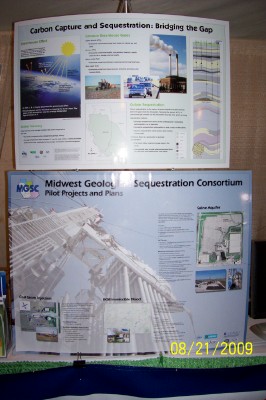After Tim Landis, Adriana Colindres is my favorite write for the SJ-R. But here is her story from another paper. I personally find these stories revolting because we in Riverton were without power for 4 hours. There wasn’t a cloud in the sky. No car crashes. No catastrophic incident like a shut down plant or a coal strike. When our local grocer (who has huge coolers thus a huge stake in the issue) asked what had happen he was told that there was squirrel damage at the local substation. These guys can’t beat squirrels but they want our money.
http://www.galesburg.com/news/x837456249/Ameren-seeks-fee-to-make-up-for-uncollectible-bills
Ameren seeks fee to make up for uncollectible bills

GateHouse News Service
SPRINGFIELD —
AmerenCIPS, AmerenCILCO and AmerenIP are asking the state’s utility regulator for permission to impose a fee on customers that would cover unpaid bills left behind by other customers.
The three companies, jointly called the Ameren Illinois Utilities, filed paperwork last week with the Illinois Commerce Commission. It’s not clear yet when the ICC will decide on the matter, or how much the fee might be.
The fee, which would appear on monthly bills, would make up for what are known as “uncollectibles” — the unpaid bills that remain after a customer’s utilities are shut off due to non-payment…..
…….
Ameren also has other business still pending before the Illinois Commerce Commission: a proposed $226 million delivery rate hike for electricity and natural gas customers. The ICC is expected to decide on that next spring.
On Tuesday, the ICC announced three public hearings in connection with the rate case.
The hearings are scheduled for Sept. 29 in hearing room A of the ICC offices, 527 E. Capitol Ave., Springfield; Oct. 5 in the Kenneth Hall Regional Office Building, 1100 Eastport Plaza, Collinsville; and Oct. 27 in the Pekin City Council Chambers, 111 S. Capitol St., Pekin.
The Ameren Illinois Utilities provide electricity to about 1.2 million customers throughout the southern two-thirds of the state. They serve more than 800,000 natural gas customers in the same areas.
:’}
http://stlouis.bizjournals.com/stlouis/stories/2009/08/03/daily50.html
Ameren seeks $185 million in stimulus
St. Louis Business Journal – by Kelsey Volkmann
Ameren’s Missouri and Illinois utilities applied this week for $185 million in stimulus money for infrastructure upgrades, smart grid projects and electric vehicles.
AmerenUE applied for $140 million in stimulus funding, and Ameren Illinois Utilities applied for $45 million.
AmerenUE’s application includes the following funding requests for a 50 percent federal match:
• $125 million in projects for modernizing the company’s Missouri delivery system.
• $15 million for an operating system that would synthesize and provide data to help better manage AmerenUE’s response to service disruptions.
• Matching funds to purchase two plug-in electric trouble trucks.
Of the total $787 billion federal stimulus package, about $43 billion is targeted for energy projects and energy efficiency. About $4.5 billion of that is targeted to support research and development of the nation’s smart grid, which delivers electricity from suppliers to consumers using digital technology.
Ameren Illinois Utilities seeks $45 million in stimulus to fund smart grid projects to improve electric service reliability. Its smart grid project will cost $83 million, of which $75 million is eligible for a 50 percent federal match of $37.5 million, the utility said.
Ameren Illinois Utilities also said it is requesting $7.5 million for a $15 million advanced distribution management system, a foundation for the smart grid project that will provide a common interface to monitor, control and manage the electrical distribution system and electrical devices.
Ameren Illinois Utilities said it plans to ask the Illinois Commerce Commission to allow the utility to add a charge to customer bills to recover AIU’s portion of the project costs.
St. Louis-based Ameren Corp. (NYSE: AEE) serves 2.4 million electric customers and 1 million natural gas customers in a 64,000-square-mile area of Missouri and Illinois
:}
http://www.themaneater.com/stories/2009/8/25/ameren-seeks-gas-price-hike-cities-around-columbia/
Ameren seeks electricity price hike in cities around Columbia
Communities around Columbia might see an increase next year.
Published Aug. 25, 2009
Correction appended
AmerenUE, the state’s largest utility company, has asked regulators for permission to raise its electric rates by as much as 18 percent, but the increase will not affect Columbia.
Ameren spokesman Mike Cleary said the increase would not directly affect MU students because the company does not provide electrical services to Columbia, only natural gas. Rates might go up in surrounding communities such as Ashland, Rocheport, Boonville and Moberly.
The company estimated the $402 million proposal would amount to an increase of about 50 cents per day for the average family. Its request comes as it is also asking for $185 million from the federal stimulus package to modernize its delivery systems. This is the company’s third request for a rate increase since 2007.
Cleary said the increase, if approved, would mostly be used to pay for reliability improvements such as reinforcing pipelines and electrical poles, and to make up for increasing delivery costs of fuel.
“We’ve just got to put everything into perspective,” Cleary said. “The reason for this increase is reliability. That’s our No. 1 priority because it’s the thing our customers have been asking us to improve the most.”
Cleary said raising rates in a down economy might affect consumers. He said Ameren has a number of programs for customers to get assistance paying bills so they will not lose service. Those programs include the ability to make minimum payments and budget billing to help eliminate sudden seasonal spikes in a family’s utility bills.
“The message we’re trying to get across is: If you’re having trouble paying the bills, call us early and don’t wait until you get a cut-off notice,” he said.
Ruth Ehresman, director of Health and Budgetary Policy for the Missouri Budget Project, said even with such programs, low-income families hit hardest by the economic crisis would face even more difficulties.
“We do know that many low-income families struggle to pay their utility bills already and a rate increase will always be problematic,” Ehresman said. “We’re always concerned when low-income families’ ability to provide basic resources is made more difficult.”
:}
I wish there something more to add, but considering their level of service and customer satisfaction ratings…what more is there to say?
:}


















 Taylorville Energy Center (TEC) is a proposed 500- to 525-megawatt clean coal power plant using an advanced technology called Hybrid Integrated Gasification Combined-Cycle (
Taylorville Energy Center (TEC) is a proposed 500- to 525-megawatt clean coal power plant using an advanced technology called Hybrid Integrated Gasification Combined-Cycle (


